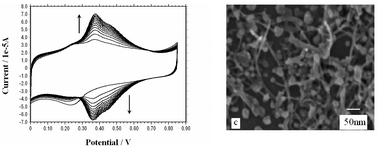Incorporating nanoclusters of nickel hexacyanoferrates (NiHCF) onto a porous polyaniline (PANI)–carbon nanotube (CNT) matrix provides a novel class of hybrid materials with a good ion exchange capacity, high stability, and selectivity for caesium ions. The CNT–PANI–NiHCF nanocomposite films have been synthesized by step-by-step electrodeposition on glassy carbon electrodes and characterized with cyclic voltammetry (CV), scanning electron microscopy (SEM), transmission electron microscopy (TEM), and X-ray photoelectron spectroscopy (XPS) techniques. CV and XPS investigations confirmed the formation of PANI and NiHCF on the surface of CNTs. The microstructure of NiHCF hybrid materials was characterized by SEM and TEM; the size of NiHCF particles is approximately 20 to 50 nm. The porous high surface area CNT matrix provides a high loading capacity for the deposition of NiHCF nanoparticles, while the PANI thin-film further stabilizes the nanoparticles. The selectivity for caesium ion adsorption of the hybrid materials was investigated. The high selectivity for caesium provides a basis for the development of a novel electrochemical ion exchange process for the treatment of nuclear waste and radioactive caesium contaminated waters.

You have access to this article
 Please wait while we load your content...
Something went wrong. Try again?
Please wait while we load your content...
Something went wrong. Try again?


 Please wait while we load your content...
Please wait while we load your content...